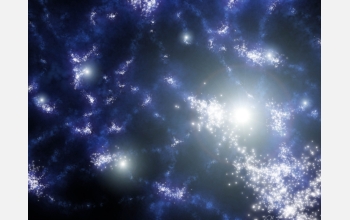News Release 05-193
Scientists See Light That May Be From First Stars in Universe
The long-sought Population III stars would have been up to 100 times more massive than the Sun
November 2, 2005
This material is available primarily for archival purposes. Telephone numbers or other contact information may be out of date; please see current contact information at media contacts.
Scientists using the National Aeronautics and Space Administration's (NASA's) Spitzer space telescope say they have detected infrared radiation that may have come from the earliest objects in the universe.
The light is too distant and feeble for the Spitzer to resolve individual sources; the science team, based at NASA's Goddard Space Flight Center in Greenbelt, Md., compares it to the glow of a distant city seen at night from an airplane.
But after data analysis funded in part by the National Science Foundation (NSF), the scientists believe the radiation is giving them a glimpse of the infant universe more than 13 billion years ago, when the fading embers of the big bang were just coming back to life.
The Goddard team says it's possible the light is coming from hot gas falling into the first black holes to form in the universe. Or, the light could be coming from the very first stars, the long-hypothesized Population III stars. (Population I and II stars, named by order of their discovery, comprise the familiar types of stars we see at night.)
If that is the case, theory suggests these first stars were likely over 100 times more massive than Earth's sun. This would have made them extremely hot, bright, and short-lived, with each one burning for only a few million years. By now, however, fierce ultraviolet light emitted by these Population III stars would have long since been stretched to lower energies by the universe's expansion--or "redshifted"--which is why the Spitzer telescope is currently picking up that light in infrared wavelengths.
The science team, led by Alexander Kashlinsky of Science Systems and Applications, Inc., has published their results in the Nov. 3 issue of the journal Nature.
For more information, see the NASA news release.
-NSF-
Media Contacts
M. Mitchell Waldrop, NSF, (703) 292-7752, email: mwaldrop@nsf.gov
Dewayne Washington, Goddard Space Flight Center, (301) 286-0040, email: Dewayne.A.Washington@nasa.gov
Principal Investigators
Alexander Kashlinsky, Science Systems and Applications, Inc., (301) 286-2176, email: kashlinsky@stars.gsfc.nasa.gov
Related Websites
Spitzer Space Telescope site: http://www.spitzer.caltech.edu/spitzer/index.shtml
NASA news release: http://www.nasa.gov/vision/universe/watchtheskies/universe_objects.html
The U.S. National Science Foundation propels the nation forward by advancing fundamental research in all fields of science and engineering. NSF supports research and people by providing facilities, instruments and funding to support their ingenuity and sustain the U.S. as a global leader in research and innovation. With a fiscal year 2023 budget of $9.5 billion, NSF funds reach all 50 states through grants to nearly 2,000 colleges, universities and institutions. Each year, NSF receives more than 40,000 competitive proposals and makes about 11,000 new awards. Those awards include support for cooperative research with industry, Arctic and Antarctic research and operations, and U.S. participation in international scientific efforts.
Connect with us online
NSF website: nsf.gov
NSF News: nsf.gov/news
For News Media: nsf.gov/news/newsroom
Statistics: nsf.gov/statistics/
Awards database: nsf.gov/awardsearch/
Follow us on social
Twitter: twitter.com/NSF
Facebook: facebook.com/US.NSF
Instagram: instagram.com/nsfgov



